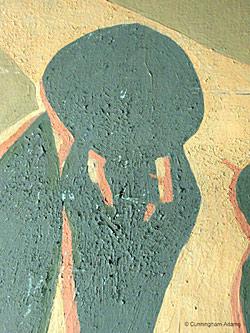
South wall, North Reading Room, Cravath Hall, Fisk University. Post-Treatment. 2003

In honor of our recent exhibition Aaron Douglas: African American Modernist, the Lunder Conservation Center presented a behind-the-scenes look at the artist's Fisk murals. In 1930, when Aaron Douglas was thirty-one he was engaged by Fisk University to create a series of murals in multiple rooms at Cravath Library. Fisk, a historically black university, was founded right after the Civil War and opened its doors in 1866. Douglas, a star of the Harlem Renaissance traveled from New York to Tennessee and created some of the most evocative murals of his career. They tell the story of the black experience from the shores of Africa to life in America in murals whose themes include: African-American spirituals, labor, and negroes in Africa as well as in America. In a 1971 interview Douglas described the cycle as a "panorama of the development of Black people in this hemisphere, in the new world."
Unfortunately, in the many years that have passed since Douglas painted the cycle, the Fisk murals fell into disrepair. Water damage, sunlight, insufficient TLC, and a host of other problems were literally eating away at the artwork. In 2002 Fisk University hired Christiana Cunningham-Adams and George Adams, owners of Cunningham-Adams Fine Arts Painting Conservation of Washington, D.C. to undertake the restoration. Christiana Cunningham-Adams shared her eye-opening stories—and amazing before and after visuals—at SAAM's Lunder Conservation Center recently, in a spirited conversation with painting conservation intern, Amber Kerr-Allison. Forget any of those extreme makeover shows you've seen on TV: what the Cunningham-Adams team did was breathtaking.
"When we first got [to Fisk] the condition [of the murals] varied," Cunningham-Adams recalled during her presentation. "In some places it was quite tragic and in other places it wasn't so bad." Besides the damage done by water and humidity—with the evaporation of moisture, salt had been left behind on the artwork— there was dirt to contend with, as well as earlier attempts at restoration. In addition, some sections of the murals had been removed and stolen.
The firm's conservation work also led to their uncovering important aspects of Douglas's style. "We made three or four extensive discoveries that impact how you might interpret Douglas's work at Fisk," recounted Cunningham-Adams. Douglas moved to Fisk in 1939 to found the art department and retired in 1966. In 1965 he did some restoration work on the murals and the university asked him to return in 1969, which coincided his seventieth birthday. These earlier restorations revealed interesting aspects of Douglas's work.
Among the discoveries were end wall murals that had been painted over and hadn't been seen for decades. In addition, they discovered that when Douglas came to Fisk in 1969 to do some touching up, he had totally repainted much of the work, in a darker, more somber palette. As Cunningham-Adams said, "It was incredible to think that he had decided to reinterpret this saga. He added darker colors to cover the airy, lyrical colors." At one point, then, the conservators were looking at two different layers of Douglas's work at the same time: the newly uncovered end walls that were painted in the 1930s and Douglas's own repainting from the 1960s. Amazing!
Early in the restoration process Cunningham-Adams made the decision that they would not add facsimiles to Douglas's work, but instead to acknowledge that some of it was gone for good. They decided to allude to the missing areas by means of geometric shapes and complementary colors reflective of Douglas's art. Their "conservation intervention" was now complete.
"Do not try this at home," Cunningham-Adams told us as we marveled at the restoration process. At the end of the discussion, Cunningham-Adams reminded us that everything she and her team undertook at Fisk had to be reversible, so that future generations of conservators could treat the murals as well. Though Douglas painted in oil, the conservators used watercolors in their treatments.
What's not reversible, however, are the kudos awarded to the conservators. Cunningham-Adams was awarded the National Trust for Historic Preservation 2004 National Preservation Award for its work on the project.


















